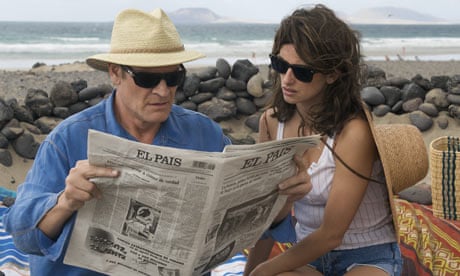The sensual pleasures of Pedro Almodóvar's lush new meta-melodrama are the more intense for being fleeting. After the movie is over and the trance has lifted, it is difficult to recall just what was so entrancing or even what the film was about. Like Oscar Wilde's famous cigarette, it is a perfect type of pleasure which leaves one not unsatisfied exactly but with a feeling that its substance has vanished into the air like smoke.
In the way of so many Almodóvar films, Broken Embraces is built on a system of dual narrative with father/son and gay/straight opposites. Lluís Homar plays a blind screenwriter in present-day Madrid with the assumed name "Harry Caine"; while still sighted, he was once a distinguished movie director working under his real name, Mateo Blanco. He hears news of the death of Ernesto Martel, a controversial Chilean financier who bankrolled his last movie as a director, and flashbacks take us to this heady period in the 1990s when in return for the plutocrat's lavish funding, Mateo cast Martel's mistress in the lead role, and had a passionate affair with her. This is the bewitching Lena, short of course for Magdalena, played by Penélope Cruz, whose beauty here reaches a swooningly hyper-real state, a camp mirage of Hollywood loveliness, especially in the scene in which she tries on various costumes and styles in the dressing room mirror, experimenting with a platinum-blonde Marilyn look. "Don't smile …" gasps the ecstatic director, "… the wig is false enough!"
Meanwhile Martel, played with tailored elegance by José Luis Gómez, orders his moody son to spy on the couple with his videocamera under the pretence of preparing a "making of" documentary. This is Ray, a sulky gay man played by Rubén Ochandiano, looking in the 90s like someone David Walliams might portray in a TV comedy called Little Spain. These flashbacks disclose dark secrets. Why is Mateo blind? And what happened to Lena herself?
The sheer, gorgeous style of Broken Embraces is what is so seductive; with his cinematographer Rodrigo Prieto, Almodóvar conjures a vivid, rich palette of colours, which have the texture of something by Alfred Hitchcock or Douglas Sirk, but his handling of the material is so confident and distinctive that it goes beyond pastiche. And with his editor, José Salcedo, he moves back and forth between the past and the present with a miraculous fluidity, and these seamless transitions are what induce the film's pleasurably dizzy, woozy quality, a subtle molestation of the audience's inner ear.
Pundits have complained that Broken Embraces just retreads the director's old ideas; I see it more as variations on a theme – familiar, but still engrossing. If the "mature" period of Almodóvar's career is levelling out, it is still producing intensely intelligent and watchable films, although observers are entitled to notice that Almodóvar is keen to stress the sexual attractiveness and prowess of older men. Broken Embraces is a film in which the director demonstrates a continuing, virtuoso fluency in a cinematic language that he himself invented. It's an embrace I want to submit to.
